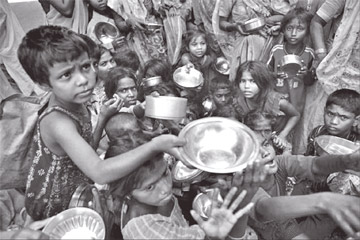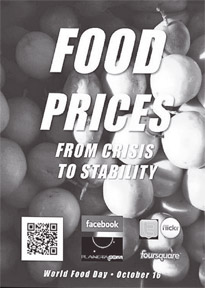|
An agriculture revolution, the answer:
Combating the food crisis
by Lionel WIJESIRI
Today is World Food Day. “Food prices – from crisis to stability” has
been chosen as this year’s theme for the event to shed light on this
crisis and what can be done to mitigate its impact on the most
vulnerable sections of society.
 It is appropriate for us to look seriously at what causes swings in
food prices, and do what needs to be done to reduce their impact on the
weakest members of our society. Price swings, upswings in particular,
represent a major threat to global food security. The hardest-hit are
developing countries such as Sri Lanka. It is appropriate for us to look seriously at what causes swings in
food prices, and do what needs to be done to reduce their impact on the
weakest members of our society. Price swings, upswings in particular,
represent a major threat to global food security. The hardest-hit are
developing countries such as Sri Lanka.
According to the World Bank, in 2010-2011, rising food prices pushed
nearly 70 million people into extreme poverty.
Compared to other countries in Asia, Sri Lanka is fortunate not to
have experienced a food crisis yet. In fact, reports indicated we would
export rice this year. The island has also taken steps to sustain and
expand the rice “revolution”. Additional measures suggested included
providing a nutrient-based subsidy to promote balanced fertilisation,
introducing mobile soil health monitoring vans that can issue soil
health passbooks to farmers and high-yielding hybrid rice strains,
coupled with sustainable rice intensification agronomic procedures.
Indian Food Security Bill
Sri Lanka has understood the gravity of the global food crisis.
President Mahinda Rajapaksa recently said that the draft Indian Food
Security Bill could provide valuable inputs to a similar Sri Lankan
initiative. The Indian Bill is designed to ensure that every citizen has
a legal right to food.
Under the Indian Food Security Bill, it is suggested that a
seven-member National Food Commission will be created, headed by a
current or former Supreme Court judge, in addition to State Commissions
presided by a High Court judge.
Their purpose is to deal with any complaints about food distribution,
and they have the authority to issue fines on any public servant that
they find guilty of misdistribution.
The Bill also outlines changes to the public distribution system (PDS),
and has delegated the distribution to be handled by “Fair Price Shops.”
These shops will be managed and operated by women and women’s groups,
further empowering women in rural Indian communities.
Food insecurity is one element of a composite global crisis prompted
by extreme inequality and the proximity of environmental limits.
Solutions to hunger can, therefore, succeed only if they reinforce
broader strategies for sustainable development.
The World Bank estimates that growth of rural economies accelerates
poverty reduction four times faster than other sectors. Small farmers
have modest carbon footprints and are relatively successful custodians
of biodiversity. Peasant farms do therefore have the potential to be
part of the solution.

To smooth over the volatility of world food prices, developing
countries are more actively creating national food reserves, perhaps
coordinated with neighbours in a regional strategy. This trend for
stronger state intervention in food policy is sometimes described as
“food sovereignty”.
Cheap fixes
I was recently reading a book titled 'Poor Economics: A Radical
Rethinking of the Way to Fight Poverty' by Abhijit Banerjee and Esther
Duflo. The book has received much attention and acclaim from economists
and development communities alike - precisely for its work in better
defining household decision making and behaviour. In particular, the
authors ask: if so many easy, cheap fixes exist, why don’t the poor take
advantage of them?
It turns out the answer is: Because they’re eating tastier foods; or
because they’re buying TVs; or because they’d rather spend money on a
wedding.
Banerjee and Duflo explains: “In Udaipur, India, for example, we find
that the typical poor household could spend up to 30 percent more on
food, if it completely cut expenditure on alcohol, tobacco, and
festivals. The poor seem to have many choices, and they don't choose to
spend as much as they can on food.”
In one anecdote, the authors recount: “We were starting to feel very
bad for him and his family when we noticed a television and a parabolic
antenna. Why had he bought all this if he didn’t have enough money for
food? He laughed and said, ‘Oh, but television is more important than
food.’”
“Equally remarkable,” the two report, “is that even the money that
people do spend on food is not spent to maximise the intake of calories
or micronutrients. Studies have shown that when very poor people get a
chance to spend a little bit more on food, they don't put everything
into getting more calories. Instead, they buy better-tasting, more
expensive calories.”
Two main lessons emerge from Banerjee’s and Duflo’s enlightening
work: Development and anti-poverty programs fail when they do not take
into account the preferences and decision-making patterns of the poor.
Food security is not just about producing enough calories to feed the
world; it’s about nourishing them.
Food security has too often been defined based on producing more or
enough food. In some cases, development agencies have also sought to
improve access to food, via physical infrastructure, market chain links,
or food subsidies. Yet, as the Indian case demonstrates, food security
requires not just production and access, but nourishing utilisation - in
other words, nutrition.
Nutrition
There has been ample evidence on the importance of nutrition for
economic, physical, and educational development. Yet often food policy
fails to link up to work on nutrition. Subsidies often explicitly favour
cereal farmers to maximise calories rather than nutrients. Poor agrarian
households still dedicate their food budgets to expensive grains, sugar,
and processed foods, rather than on more nutritional leafy vegetables or
coarse grains.
The solution must come in varied forms. Research and field extension
to develop and promote bio-fortified food crops, raising the profile of
traditional nutritious foods (and keeping them affordable), and
educating and giving grants or subsidies to women (who are the primary
carers of infants and small children, for whom nutrition is most
important) are some good options. But for development and agricultural
agencies, innovative “nudging” may need to play its part too.
The global food price spikes since 2006 are thought to be part of a
long-term trend of higher and more volatile food prices, driven by an
imbalance between food demand and supply, exacerbated by more erratic
and extreme weather and by poorly functioning agricultural markets. The
strengthening of the link between food and energy prices is also a
factor.
The projected growth in Sri Lanka's population to 23 million by 2030
adds an extra challenge for food security. Burgeoning populations mean
more demand for food, water and land at a time when the natural resource
base for agriculture is being degraded, large areas of farmland are
being diverted from food crop production, and climate change threatens
to further reduce agriculturally viable land.
To address these challenges, robust and carefully targeted investment
is needed, along with comprehensive policy frameworks at global,
regional and national levels.
In Sri Lanka, the majority of farming population is small and
family-run, and they produce most of the food consumed locally.
Smallholders are also by far the main investors in agriculture.
Smallholder farmers
Smallholder farmers can significantly contribute to economic growth,
as well as to reducing poverty and ensuring food and nutrition security.
For example, Vietnam went from being a food-deficient country to the
second largest rice exporter in the world, largely by developing its
smallholder farming sector.
However, smallholder farmers need more secure access to land and
water, and better access to financial services to pay for seed, tools
and fertiliser.
They need better functioning markets that provide incentives to
invest in improving production, with less risk; roads and transportation
to get their products to market; and access to technology for up-to-date
and reliable market information. They need agricultural research and
technology to raise productivity and improve their resilience to natural
resource degradation and climate change.
And they need stronger organisations to pool their resources, better
manage risk, have greater bargaining power in the market place, and
influence agricultural policies and public investments.
Above all, they need a long-term commitment from the Government to
developing the potential of smallholder agriculture. |

